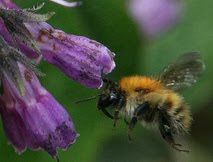My neighbors have a huge tulip tree which overhangs Comfrey Cottages on the north. It’s flowers are so absolutely gorgeous! The bees have been very busy gathering nectar from it and I can hear them buzzing happily high up in its branches. I have always appreciated this trees for the shade it provides and its nectar and pollen it provides the bees. The squirrels are eating the mature buds also, with apparent relish. Well I decided to research and find out whether this tree might have edible or medicinal qualities, that we could benefit from also. What I found was most interesting indeed! While I can find no references to eating the Tulip Tree, in any form, Henrietta’s Herbal had a couple pages chock full of historical references to it’s usage as medicine. It seems that it has been basically ignored in years though. I think that I will explore some of the medicinal uses listed this year since I have a very keen interest in using the trees and plants that are easily available in my area. Luckily I have some Amish friends that harvest trees, so I can ask them to share some of the inner bark of the root the next time they cut one. I will share about it whenever I get a chance to work with it. Of course, I don’t intend to do anything but enjoy the blessings of the tree overhanging our gardens here:)
One of the pages Henrietta has is information from John Scudder on this tree.
“The bark of Liriodendron tulipifera.—U. S.
Preparation.—Tincture of Liriodendron.
Dose.—From five drops to one drachm.
Therapeutic Action.—The bark of the Tulip Tree is tonic, stimulant, diaphoretic, diuretic, anthelmintic, aromatic, stomachic. It may be used in all cases of anorexia and impaired states of the digestive organs, where a stimulant tonic is indicated. It promotes the appetite and facilitates digestion; for these purposes it will be found fully equal to the simple bitters. It is often used with some advantage in intermittents.
It is employed in gout and chronic rheumatism, and in the declining stages of the acute form, after the irritated action has subsided, as a stimulating diaphoretic and tonic. If administered freely in the form of a warm infusion, it evinces conspicuous diaphoretic properties; and not unfrequently its diuretic powers are equally manifest.
The American Eclectic Materia Medica and Therapeutics, 1898, was written by John M. Scudder, M.D.”
Very interesting, right? lol














5 comments:
Very interesting! This tree certainly has beautiful flowers. I think I will Google it and find out more. I wonder how they would grow where I live.
That is indeed interesting. And so beautiful. I had never heard of this tree before.
Interesting! We have several of those trees here as well. Everything was put here for a purpose, if we only listen!
i just love this tree! gorgeous for shade, wildlife loves it, and the flowers are so different and pretty. you are so right ulrike:)
I have also never heard of this tree with his beautiful flowers.
Post a Comment